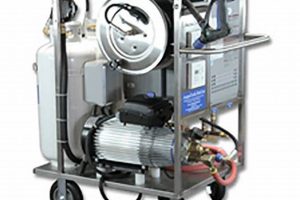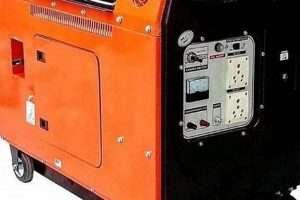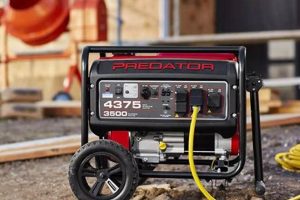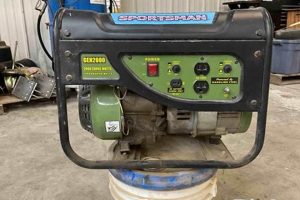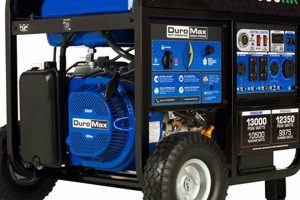A high-quality, appropriately sized power cable is essential for safely and effectively connecting appliances to a portable generator. This cable must be capable of handling the generator’s electrical output without overheating or causing voltage drops. For instance, a heavy-duty cable with a low gauge and sufficient length is required for powering high-wattage devices like refrigerators or power tools. Choosing an inadequate cable can lead to appliance damage, generator malfunction, or even electrical hazards.
Proper cable selection ensures the safe and reliable operation of electrical equipment powered by portable generators, preventing potential fires and equipment damage. Historically, improper cable usage has been a significant contributor to generator-related accidents. Selecting the correct cable size and type minimizes energy loss, maintains consistent power delivery, and extends the lifespan of connected appliances. This is particularly crucial in emergency situations, where reliable power can be life-saving.
The following sections will delve into the key factors influencing cable selection, such as gauge, length, amperage rating, and connector types. Additionally, safety precautions and best practices for using generator power cables will be discussed in detail.
Tips for Selecting and Using Generator Extension Cords
Safe and efficient generator operation relies heavily on proper extension cord selection. These tips offer guidance on choosing and utilizing appropriate power cables.
Tip 1: Calculate Total Wattage: Determine the combined wattage of all devices intended for connection to the generator. This calculation ensures the chosen cable can handle the electrical load.
Tip 2: Select Appropriate Gauge: Lower gauge numbers indicate thicker wires capable of carrying higher currents. Using a cable with insufficient gauge can lead to overheating and voltage drops.
Tip 3: Consider Cable Length: Longer cables introduce greater resistance, potentially reducing voltage at the device end. Choose the shortest practical length to minimize power loss.
Tip 4: Check Amperage Rating: Ensure the cable’s amperage rating matches or exceeds the generator’s output and the combined load of connected appliances.
Tip 5: Inspect for Damage: Before each use, thoroughly inspect the cable for cuts, fraying, or exposed wires. Damaged cables pose a serious safety hazard.
Tip 6: Avoid Overloading: Never exceed the cable’s rated capacity. Overloading can cause overheating, fire, and equipment damage.
Tip 7: Proper Storage: Store cables in a dry, cool location, free from sharp objects or chemicals. Proper storage prolongs cable lifespan and prevents damage.
Adhering to these guidelines ensures efficient power delivery, protects connected equipment, and promotes safe generator operation, mitigating potential risks and maximizing performance.
By understanding and implementing these practical tips, users can optimize their generator setup for safety and reliability, ensuring a consistent and dependable power supply.
1. Heavy-duty construction
Heavy-duty construction is a critical factor in selecting the best extension cord for a portable generator. Cords intended for generator use often face demanding conditions, including exposure to the elements, heavy loads, and potential abrasion. A robust construction, characterized by thick insulation, reinforced jackets, and strain relief at connector ends, ensures durability and longevity. This safeguards against premature wear and tear, preventing electrical hazards and maintaining reliable power delivery even under challenging circumstances. For instance, a construction site might require a cord capable of withstanding heavy foot traffic and exposure to moisture, demanding a heavy-duty design.
The practical implications of heavy-duty construction directly impact user safety and equipment protection. A well-built cord resists damage from physical stress, minimizing the risk of exposed wires and subsequent shocks or short circuits. This durability also translates to reliable power transmission, preventing voltage fluctuations that can harm sensitive electronics. Consider a scenario where a generator powers essential medical equipment during a power outage; a heavy-duty cord ensures uninterrupted operation, protecting both the equipment and the individual relying on it.
In summary, heavy-duty construction is not merely a desirable feature but a critical requirement for extension cords used with portable generators. Its impact on safety and performance cannot be overstated. Choosing a cord built to withstand demanding conditions ensures reliable operation, protects connected equipment, and mitigates potential hazards, ultimately contributing to the selection of the best possible power cable for any given application.
2. Appropriate Gauge (Thickness)
Appropriate gauge, referring to the thickness of the conducting wires within an extension cord, is paramount when selecting the best cord for a portable generator. Gauge is inversely related to current-carrying capacity; a lower gauge number signifies a thicker wire capable of handling higher electrical currents. Using an inadequate gaugeone too thin for the required amperageresults in excessive resistance, leading to voltage drop and overheating. This can damage connected appliances, cause the cord to melt, and potentially create fire hazards. For instance, attempting to power a high-wattage appliance like a refrigerator with a thin, high-gauge cord will likely result in insufficient power delivery and overheating.
The practical implications of selecting the appropriate gauge are significant for both equipment performance and safety. Adequate wire thickness ensures that appliances receive the necessary voltage for optimal operation, preventing malfunctions and extending their lifespan. Furthermore, the correct gauge minimizes heat buildup within the cord, significantly reducing the risk of fire. Consider a scenario where a generator powers essential communication equipment during an emergency; using the correct gauge ensures reliable operation of the equipment, facilitating vital communication. Conversely, an undersized cord could lead to equipment failure at a critical moment.
In conclusion, the relationship between appropriate gauge and extension cord performance is fundamental. Matching the gauge to the generator’s output and the connected load ensures efficient power delivery, protects valuable equipment, and mitigates potential safety hazards. Understanding this connection is crucial for selecting the best extension cord for any portable generator application, ensuring both reliability and safety.
3. Sufficient Length
Sufficient length is a crucial consideration when selecting an extension cord for a portable generator. While adequate length provides necessary reach and flexibility, excessive length introduces potential performance and safety issues. Balancing these considerations is essential for optimal generator operation.
- Reaching Power Needs:
Cords must reach the intended power source and the devices requiring power. Practical considerations include the generator’s placement relative to the appliances and any obstacles in the path. For example, during a power outage, a homeowner might need to position the generator outdoors while powering appliances inside the house, necessitating a cord of sufficient length to bridge this distance safely.
- Voltage Drop Over Distance:
Longer cords inherently possess greater electrical resistance. This resistance leads to voltage drop, particularly under heavy loads. Appliances may receive insufficient power, resulting in malfunction or damage. A cord that is too long can cause a noticeable voltage drop, particularly when powering high-wattage appliances like electric heaters or power tools.
- Safety Hazards of Excessive Length:
Excessively long cords pose tripping hazards and increase the risk of entanglement. They are also more susceptible to damage from environmental factors. A tangled or damaged cord can lead to electrical shocks or fires. In a cluttered work environment, an overly long cord presents a significant safety risk.
- Balancing Length and Practicality:
The ideal cord length balances reach with performance and safety. Choosing the shortest practical length minimizes voltage drop and safety risks while providing the necessary flexibility. For instance, using multiple shorter cords connected to a power distribution block can be safer and more efficient than using a single, excessively long cord.
In conclusion, careful consideration of cord length ensures efficient and safe generator operation. Balancing the need for reach with the risks associated with excessive length contributes to optimal performance and mitigates potential hazards. Selecting the appropriate cord length is thus a critical aspect of choosing the best extension cord for any portable generator application.
4. Outdoor rating
Outdoor rating is a critical factor in selecting an extension cord for use with a portable generator, especially given the likelihood of outdoor operation. Cords lacking an appropriate outdoor rating are susceptible to damage and pose safety hazards when exposed to the elements. Sunlight, moisture, temperature fluctuations, and abrasion can degrade the cord’s insulation, leading to potential shorts, shocks, and fire risks. For instance, using an indoor-rated cord in wet conditions could result in a dangerous electrical hazard. A properly outdoor-rated cord, designed to withstand ultraviolet radiation, moisture, and temperature extremes, ensures safe and reliable operation in various environmental conditions. Such cords are often constructed with thicker insulation, weather-resistant jackets, and reinforced connectors to enhance durability and safety.
The practical significance of an outdoor rating extends beyond mere weather resistance. It directly impacts the cord’s longevity, preventing premature degradation and maintaining reliable performance over time. This durability translates into consistent power delivery to connected appliances, protecting them from voltage fluctuations and potential damage. Consider a scenario where a generator powers essential equipment during a natural disaster; an outdoor-rated cord ensures continued operation despite challenging weather conditions. Conversely, an indoor-rated cord might fail, compromising critical services. Furthermore, the safety implications are paramount. An outdoor-rated cord significantly reduces the risk of electrical hazards, safeguarding users and property from potential harm.
In summary, prioritizing an outdoor rating is paramount when selecting an extension cord for a portable generator. This rating signifies the cord’s ability to withstand environmental stressors, ensuring safe and reliable operation in outdoor settings. Choosing a cord with the appropriate outdoor rating not only protects connected equipment but also mitigates potential hazards, contributing significantly to the selection of the best extension cord for any given application. Ignoring this critical aspect can compromise safety and performance, potentially leading to equipment damage, electrical hazards, or even loss of critical services during emergency situations.
5. Amperage Compatibility
Amperage compatibility is a critical factor when selecting an extension cord for a portable generator. The cord’s amperage rating must align with both the generator’s output and the combined current draw of the connected devices. A mismatch can lead to overheating, fire hazards, and equipment damage. Choosing a cord with insufficient amperage capacity compromises safety and reliability.
- Matching Cord, Generator, and Load:
The extension cord’s amperage rating must equal or exceed both the generator’s maximum output and the total amperage requirements of the connected devices. For example, a generator producing 10 amps requires a cord rated for at least 10 amps, and if the combined load of the connected appliances is 8 amps, the cord must still be rated for at least 10 amps. This ensures safe current flow and prevents overheating.
- Overheating and Fire Hazards:
Using a cord with an inadequate amperage rating forces the cord to carry more current than it is designed to handle. This excessive current flow generates heat, which can melt the cord’s insulation, potentially leading to short circuits and fires. Overloading a 10-amp cord with a 15-amp load, for instance, poses a significant fire hazard.
- Equipment Damage:
Insufficient amperage can also damage connected appliances. Reduced current flow, or voltage drop caused by the overloaded cord, can prevent appliances from operating correctly, potentially leading to overheating or permanent damage. A voltage drop can cause sensitive electronic equipment to malfunction.
- Determining Amperage Requirements:
Generator output amperage is typically found on the generator’s specifications label. Appliance amperage requirements are often listed on the appliance itself or in its user manual. Calculating the total amperage draw of multiple devices involves summing the individual amperage requirements of each device. Consulting these resources ensures the selected cord has the necessary amperage capacity.
Selecting an extension cord with the correct amperage rating is paramount for safe and efficient portable generator operation. A cord with insufficient capacity creates a fire hazard and risks damaging connected equipment. Careful consideration of amperage compatibility ensures reliable power delivery and prevents potentially dangerous outcomes. Understanding the relationship between amperage, generator output, and connected loads is thus fundamental to choosing the best extension cord for any application.
6. Proper Connectors
Proper connectors are essential for safe and efficient power delivery when using a portable generator. Connector compatibility and quality directly impact performance, preventing power loss, equipment damage, and potential hazards. Choosing the correct connectors is thus a crucial aspect of selecting the best extension cord.
- Connector Type Compatibility:
Connectors must be compatible with both the generator’s outlets and the inlets of the devices being powered. Mismatched connectors prevent power transfer and can damage equipment. For example, a generator with a L14-30 outlet requires an extension cord with a matching L14-30 plug, and the appliance end must have a connector that matches the appliance’s inlet. Using an adapter can sometimes work, but always verify it’s rated for the wattage/amperage of the devices being used.
- Connector Quality and Durability:
High-quality connectors are essential for reliable, long-lasting performance. Connectors constructed from durable materials, such as heavy-duty plastic or reinforced metal, withstand wear and tear, preventing connection failures. Inferior connectors can overheat, corrode, or break, leading to power interruptions and safety risks. A robustly constructed connector maintains a secure connection, minimizing voltage drops and ensuring consistent power flow.
- Number of Connectors/Configuration:
The number and configuration of connectorswhether a single connector or multiple outletsdepend on the intended application. A single connector suffices for powering a single appliance, while multiple outlets facilitate powering several devices simultaneously. Using a splitter on a single connector cord can be hazardous unless the combined wattage of the connected devices is well within the cord’s limits. A distribution block with multiple outlets offers a safer solution for powering multiple devices. The configuration choice depends on the specific power requirements of the situation.
- Locking Mechanisms:
Connectors equipped with locking mechanisms, such as twist-lock or push-lock designs, provide secure connections that resist accidental dislodging. This is particularly important in demanding environments or situations where movement or vibration could disrupt the power supply. Secure connections minimize the risk of power interruptions and enhance overall safety. For critical applications, twist-lock connectors provide added security and are less likely to disconnect accidentally.
The selection of proper connectors is thus integral to the overall performance and safety of a portable generator setup. Connector compatibility, quality, configuration, and locking mechanisms all contribute to reliable power delivery, equipment protection, and hazard mitigation. Choosing the right connectors, alongside other key considerations like gauge and length, ensures the best possible performance and safeguards against potential issues. Overlooking connector specifications can compromise the entire system, leading to inefficient operation, equipment damage, and potential safety risks.
Frequently Asked Questions
This section addresses common inquiries regarding extension cord selection for portable generators, providing clear and concise information to ensure safe and effective power delivery.
Question 1: How is the appropriate extension cord gauge determined for a portable generator?
The correct gauge depends on the generator’s output and the total wattage of connected appliances. Higher wattage and longer distances necessitate lower gauge (thicker) cords to prevent voltage drop and overheating.
Question 2: Can any outdoor extension cord be used with a portable generator?
While many outdoor extension cords exist, specific features are crucial for generator use. Heavy-duty construction, a suitable gauge for the intended load, and proper connector compatibility are essential.
Question 3: What are the risks of using an undersized extension cord?
Undersized cords overheat due to excessive current flow. This can damage the cord, connected appliances, and the generator itself, potentially creating a fire hazard. Voltage drop, resulting from insufficient current delivery, can also malfunction appliances.
Question 4: Does extension cord length affect generator performance?
Longer cords increase electrical resistance, leading to voltage drop, especially with higher loads. Choosing the shortest practical length minimizes performance issues and ensures efficient power delivery.
Question 5: Are there specific connector types recommended for generator use?
Connector types must match the generator’s outlets and appliance inlets. Twist-lock connectors offer added security against accidental disconnection, particularly in demanding applications or environments prone to vibrations.
Question 6: How does ambient temperature impact extension cord selection?
Ambient temperature influences a cord’s current-carrying capacity. High temperatures can increase resistance and reduce the cord’s effective amperage rating. Consult manufacturer guidelines for specific temperature considerations.
Careful consideration of these factors ensures safe and efficient generator operation. Consulting manufacturer specifications and professional electricians provides further guidance.
For further detailed information on specific generator models and applications, please consult the subsequent sections.
Best Extension Cord for Portable Generator
Selecting the appropriate extension cord for a portable generator is paramount for safe and efficient operation. Critical factors include heavy-duty construction, appropriate gauge, sufficient length, outdoor rating, amperage compatibility, and proper connectors. Careful consideration of these elements ensures reliable power delivery to connected appliances while minimizing risks such as overheating, voltage drop, and fire hazards. Ignoring these factors can compromise both equipment and user safety.
Prioritizing informed extension cord selection contributes significantly to maximizing the utility and safety of portable generators. Understanding the interplay of these crucial factors empowers users to make responsible decisions, optimizing performance and mitigating potential risks. This proactive approach ensures reliable power delivery in various situations, safeguarding both equipment and individuals.

